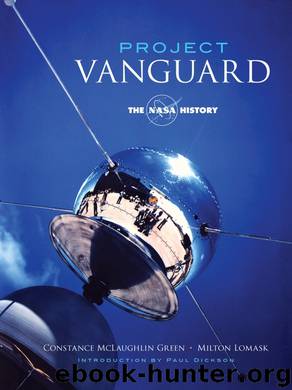Project Vanguard by Green Constance McLaughlin; Lomask Milton; Dickson Paul & Milton Lomask

Author:Green, Constance McLaughlin; Lomask, Milton; Dickson, Paul & Milton Lomask
Language: eng
Format: epub
ISBN: 1900940
Publisher: Dover Publications
Published: 2012-10-23T04:00:00+00:00
9
THE TRACKING SYSTEMS
TRACKING, as the term indicates, means measuring the position of a moving object, natural or man-made. Optical tracking with sighting instruments is as old as astronomy, which is at least as old as written history. A child of modern science, radio tracking using radar, radio direction finders, Dovap, and other electronic schemes, emerged during the first quarter of the twentieth century. Radio interferometry, the technique employed in Vanguard’s electronic tracking system, entered the picture in the 1940s. Like most of the electronic tracking techniques then in use, this one required the presence of a signal source, a transmitter, in the object being tracked. Employing two receiving points on the ground and comparing the phases of the signals each of them separately received from the airborne source, radio interferometry had the advantage of yielding highly accurate angles.
It achieved practical form in 1948 when engineers with Consolidated Vultee Aircraft Corporation (Convair) created for the Army the Azusa tracking system, using an interferometer.1 Simultaneously with this development, NRL scientists were working with underwater sound interferometers. The two groups of experimenters were in close contact. They frequently exchanged ideas, and in the early 1950s Milton Rosen and his NRL crew at White Sands built and field tested a tracking system, using the radio interferometer principle, for application to ballistic missile guidance for the Viking rocket.2
When in early 1955 Hagen’s people, specifically Rosen and his colleagues, began drawing up their plans for launching an earth satellite, they devoted much thought to the problem of tracking so small an object. Most upper-air research scientists advised them to rely on optical tracking. It was the tried and true method. More to the point, Fred L. Whipple’s camera observations of meteorites entering the earth’s atmosphere had demonstrated in the late 1940s that modern terrestrial optical instruments could “spot” an object weighing only a few kilograms and moving at a substantial distance.3
Rosen had doubts. At his request Richard Tousey of NRL checked Whipple’s visibility computations. He confirmed these calculations, but found in them no answer to an important question: Granted optical instruments could see the satellite if they could find it in the first place—but could they find it? In Tousey’s opinion their chances of doing so were only one in a million.4 There was the further consideration that optical tracking, although highly accurate, has limitations. The best of sighting instruments can pick up a satellite only when the sun is five degrees below the horizon—that is, at dusk and dawn—and even then only under certain weather conditions.5 Convinced from the beginning that NRL must look elsewhere for an adequate satellite-acquisition method, Rosen had asked John T. Mengel and his NRL Tracking and Guidance Branch to develop an electronic system for use in conjunction with an optical one.
For guidance purposes, the Azusa system had performed satisfactorily at White Sands and elsewhere. For tracking a satellite, however, it was out of the question since it required an airborne transmitter far too large for a small scientific payload weighing no more than thirty pounds, if that much.
Download
This site does not store any files on its server. We only index and link to content provided by other sites. Please contact the content providers to delete copyright contents if any and email us, we'll remove relevant links or contents immediately.
| Automotive | Engineering |
| Transportation |
Whiskies Galore by Ian Buxton(41515)
Introduction to Aircraft Design (Cambridge Aerospace Series) by John P. Fielding(32876)
Small Unmanned Fixed-wing Aircraft Design by Andrew J. Keane Andras Sobester James P. Scanlan & András Sóbester & James P. Scanlan(32560)
Craft Beer for the Homebrewer by Michael Agnew(17920)
Turbulence by E. J. Noyes(7684)
The Complete Stick Figure Physics Tutorials by Allen Sarah(7127)
Kaplan MCAT General Chemistry Review by Kaplan(6572)
The Thirst by Nesbo Jo(6425)
Bad Blood by John Carreyrou(6261)
Modelling of Convective Heat and Mass Transfer in Rotating Flows by Igor V. Shevchuk(6216)
Learning SQL by Alan Beaulieu(6018)
Weapons of Math Destruction by Cathy O'Neil(5807)
Man-made Catastrophes and Risk Information Concealment by Dmitry Chernov & Didier Sornette(5632)
Digital Minimalism by Cal Newport;(5364)
Life 3.0: Being Human in the Age of Artificial Intelligence by Tegmark Max(5169)
iGen by Jean M. Twenge(5145)
Secrets of Antigravity Propulsion: Tesla, UFOs, and Classified Aerospace Technology by Ph.D. Paul A. Laviolette(4965)
Design of Trajectory Optimization Approach for Space Maneuver Vehicle Skip Entry Problems by Runqi Chai & Al Savvaris & Antonios Tsourdos & Senchun Chai(4833)
Electronic Devices & Circuits by Jacob Millman & Christos C. Halkias(4731)
